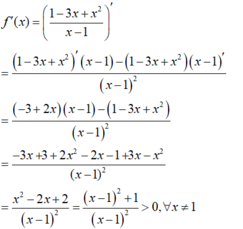Hãy nhập câu hỏi của bạn vào đây, nếu là tài khoản VIP, bạn sẽ được ưu tiên trả lời.

Ta có: \(f'\left(x\right)=x^2-2x-3\)
\(f'\left(x\right)\le0\\ \Rightarrow x^2-2x-3\le0\\ \Leftrightarrow\left(x+1\right)\left(x-3\right)\le0\\ \Leftrightarrow-1\le x\le3\)

\(f'\left(x\right)=x^2+x+1\) luôn lớn hơn 0 mà :3 vậy f'(x) \(\le\)0 là k có :3
f'(x)= tính thế nào? hay là tính sai
nếu đúng vậy chọn PA (A) rỗng

\(\lim\limits_{x\rightarrow0^+}f\left(x\right)=\lim\limits_{x\rightarrow0^+}\left(m+\frac{1-x}{1+x}\right)=m+1\)
\(\lim\limits_{x\rightarrow0^-}f\left(x\right)=\lim\limits_{x\rightarrow0^-}\frac{\left(\sqrt{1-x}-\sqrt{1+x}\right)\left(\sqrt{1-x}+\sqrt{1+x}\right)}{x\left(\sqrt{1-x}+\sqrt{1+x}\right)}=\lim\limits_{x\rightarrow0^-}\frac{-2x}{x\left(\sqrt{1-x}+\sqrt{1+x}\right)}\)
\(=\lim\limits_{x\rightarrow0^-}\frac{-2}{\sqrt{1-x}+\sqrt{1+x}}=-1\)
Để hàm số liên tục tại x=0
\(\Leftrightarrow\lim\limits_{x\rightarrow0^+}f\left(x\right)=\lim\limits_{x\rightarrow0^-}f\left(x\right)=f\left(0\right)\)
\(\Leftrightarrow m+1=-1\Rightarrow m=-2\)
Bài 2:
Đặt \(f\left(x\right)=4x^4+2x^2-x-3\)
\(f\left(x\right)\) là hàm đa thức nên liên tục trên mọi khoảng thuộc R
\(f\left(-1\right)=4>0\) ; \(f\left(0\right)=-3< 0\)
\(\Rightarrow f\left(-1\right).f\left(0\right)< 0\Rightarrow f\left(x\right)\) có ít nhất 1 nghiệm trên \(\left(-1;0\right)\)
\(f\left(1\right)=2>0\Rightarrow f\left(0\right).f\left(1\right)< 0\Rightarrow f\left(x\right)\) có ít nhất 1 nghiệm trên \(\left(0;1\right)\)
Vậy \(f\left(x\right)\) có ít nhất 2 nghiệm trên \(\left(-1;1\right)\)

Chọn C.
Vì: f’(x) = 15(x + 1)2 + 4 ;
f”(x) = 30(x + 1) ⇔ f”(x) = 0 ⇔ x = -1.

Đáp án C
Ta có : f ' ( x ) = 15 ( x + 1 ) 2 + 4 ;
f ' ' ( x ) = 30 ( x + 1 ) ⇒ f ' ' ( x ) = 0 ⇔ 30 ( x + 1 ) = 0 ⇔ x = - 1 .

2: ĐKXĐ: x<>1
\(f'\left(x\right)=\dfrac{\left(x^2-3x+3\right)'\left(x-1\right)-\left(x^2-3x+3\right)\left(x-1\right)'}{\left(x-1\right)^2}\)
\(=\dfrac{\left(2x-3\right)\left(x-1\right)-\left(x^2-3x+3\right)}{\left(x-1\right)^2}\)
\(=\dfrac{2x^2-5x+3-x^2+3x-3}{\left(x-1\right)^2}=\dfrac{x^2-2x}{\left(x-1\right)^2}\)
f'(x)=0
=>x^2-2x=0
=>x(x-2)=0
=>\(\left[{}\begin{matrix}x=0\\x=2\end{matrix}\right.\)
1:
\(f\left(x\right)=\dfrac{1}{3}x^3-2\sqrt{2}\cdot x^2+8x-1\)
=>\(f'\left(x\right)=\dfrac{1}{3}\cdot3x^2-2\sqrt{2}\cdot2x+8=x^2-4\sqrt{2}\cdot x+8=\left(x-2\sqrt{2}\right)^2\)
f'(x)=0
=>\(\left(x-2\sqrt{2}\right)^2=0\)
=>\(x-2\sqrt{2}=0\)
=>\(x=2\sqrt{2}\)

\(f'\left(x\right)=\left(x^2e^{-2x}\right)'=2x\cdot e^{-2x}-2x^2e^{-2x}\\ f'\left(x\right)=0\\ \Rightarrow2xe^{-2x}-2x^2e^{-2x}=0\\ \Leftrightarrow2xe^{-2x}\cdot\left(1-x\right)=0\\ \Leftrightarrow\left[{}\begin{matrix}x=0\\x=1\end{matrix}\right.\)

Đáp án C.
- Phương pháp:
+) Tính f'(x).
+) Sử dụng quy tắc trong trái ngoài cùng giải bất phương trình bậc hai.
- Cách giải:
+ Ta có:
→ Vậy tập nghiệm của bất phương trình là